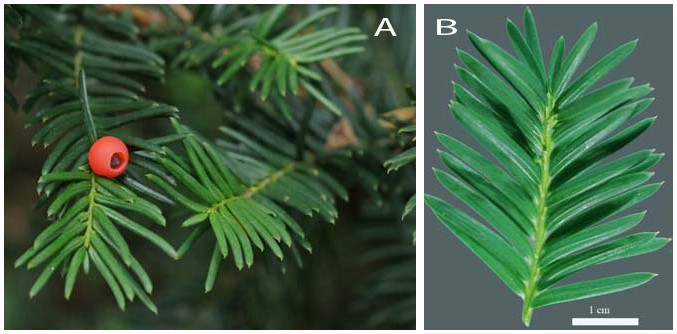In August 2006, in St. Joseph County, Michigan, a farmer found out the hard way that yews (Taxus spp.) are extremely toxic to cattle. A few overgrown bushes were removed from a landscape one afternoon and pulled into a pasture area. The intention was to burn them once all were removed and dried. The next morning, all 10 cattle in the pasture were dead. Plant material submitted to the lab was identified as Japanese yew (Taxus cuspidata).
Taxus is the genus that includes numerous forms of evergreen shrubs or trees used in the landscape. Common species include Canada yew (T. canadensis), English yew (T. baccata), Japanese yew (T. cuspidata) and Anglojap yew (Taxus x media). Cultivars of the Anglojap yew, a cross between T. cuspidata and T. baccata, are some of the most encountered at garden stores.
Yews have linear, sharp-pointed, approximately one-inch long, needle-like leaves that are dark green above and yellow green below. Leaves are spirally arranged but generally lie flat on the stem. Flowers are inconspicuous with mildly attractive, red, berry-like fruit.
All parts of yews, except the red, fleshy part around the seed, are extremely toxic to cattle and other livestock. The primary toxin is taxine, which is a mixture of alkaloids that act upon the heart and usually result in death of the animal. Uprooted bushes and clippings should never be placed near livestock. Yew is generally not highly palatable to livestock. However, animals are more likely to graze on tender new growth or clippings discarded in a pasture. As little as a mouthful to 1 lb. of yew clippings is sufficient to kill a 1000 lb. animal in only a few minutes.
axus spp. (Fig. 1) is the most commonly-diagnosed plant toxicosis at the AHL. A review of pathology cases from 1989 to Oct 2020 found 25 submissions (10 cattle, 8 equids, 2 goats, 2 sheep, 1 turkey and 1 deer) (Table 1). Five of the equine submissions involved two or three animals.

Figure 1. Taxus spp. (yew) showing typical evergreen leaves and red fleshy fruit (A). Note the fine point at the tip of the needle-like leaves (B).
Diagnosis is usually made by a history of unexpected death and finding the typical leaves in stomach or mouth. Stomach content can also be tested at an external laboratory for taxine, the toxin which is a cardiotoxic alkaloid that interferes with cardiac conduction. Death is rapid, often within 1-3 hours of ingestion, although this is dose-dependent. There is no treatment for the acute syndrome. Any prunings or plant material should be immediately removed from access by the herd. Horses are more sensitive to the toxin than ruminants, pigs or dogs.1 Depending on how long the animal lives, there may not be histologic lesions visible in the heart. AHL
Table 1. Taxus spp. AHL pathology submissions, species affected and histories, 1989 - October 2020.
Reference
Tiwary AK et al. Diagnosis of Taxus (Yew) poisoning in a horse. J Vet Diagn Invest 2005;17:252-255.
